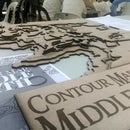Introduction: Trash Compactor (Plunger Type)
Nowadays, trash is a significant problem to our society. We are all highly encouraged to throw our trash in the right waste bin. But what happens if our trash cans are already filled with trash? For most institutions, there are certain personnel that are responsible for the management and the clean-up of each trash bin. If these personnel are not available, the trash builds up and sometimes overflows from the bin. The developed plunger-type trash compactor can be used by anyone to create more space for more trash to be placed in the trash can.
Step 1: Source Your Materials
PVC pipe or stainless steel pipes. I used an old cabinet rail (for hanging clothes), but I had to buy the PVC pipe to test it out.
Screw not more than 18 mm in length
T shaped pipe fitting
Water-based elastomeric sealant
Epoxy or any adhesive for PVC pipes
Plywood preferably 18 mm thick
Step 2: Cut the Pipes
PVC Pipe
Cut the PVC pipe or stainless steel pipe to the desired size. The handles will vary based on your preference and the body will vary based on the size of your trash bin. For this project I used a handle of width 230mm and a body of height 1000mm.
Stainless Steel Pipe
If the pipe is too long for a handle and body, you will have to use a power tool or have it cut in a welding shop.
Step 3: Attach/Connect the Pipes
PVC Pipe
Attach the handles and the body to the T shaped pipe fitting and apply adhesive.
Stainless Steel Pipe
For the stainless steel pipe, you will have to weld the handle and the body together.
Step 4: Cut the Plywood
Cut the plywood based on the dimensions of your trash bin. For this project I made it a 240mm x 240mm square and I also made another base with a hexagonal shape. Add holes so that the air inside the trash bin will be released while the trash is being compressed. I used a CNC router to cut the hexagonal base with holes.
Step 5: Attach the Plywood to the Body
Attach the plywood to the body just like in the picture above. For the smaller compactor, since I got the stainless steel pipe from a wardrobe, it was already attached to a cylindrical connector with holes where screws can be attached. Then, I attached the body to the plywood using screws. For the larger compactor, I cut a circular hole on the center of the plywood and then I hammered the plywood in place. The compactor was already sturdy but I still applied an adhesive to ensure that the base will not be easily removed from the body.
Step 6: Waterproof the Plywood
Coat the entire surface of the plywood with water-based sealant to waterproof it. The sealant must strictly be water-based to prevent the wood from rotting.
Step 7: Test Your Compactor
Finally you're done! You have successfully constructed a trash compactor! The final step is to test it out and to make sure that the whole thing is sturdy.







![Tim's Mechanical Spider Leg [LU9685-20CU]](https://content.instructables.com/FFB/5R4I/LVKZ6G6R/FFB5R4ILVKZ6G6R.png?auto=webp&crop=1.2%3A1&frame=1&width=306)





